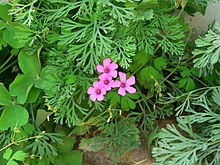Purple wood sorrel
| Purple wood sorrel | ||||||||||||
|---|---|---|---|---|---|---|---|---|---|---|---|---|

Violet wood sorrel ( Oxalis violacea ) |
||||||||||||
| Systematics | ||||||||||||
|
||||||||||||
| Scientific name | ||||||||||||
| Oxalis violacea | ||||||||||||
| L. |
Violet sorrel ( Oxalis violacea ) is a plant from the genus sorrel ( Oxalis ). It is native to the United States and is used as an ornamental and eaten by humans. The parts of the plant contain oxalic acid .
description
Appearance and leaf
Oxalis violacea grows as a perennial herbaceous plant . This geophyte forms underground tubers covered with scales as permanent organs with which clonal populations can be formed. There are fiber roots formed on the tubers.
The basal leaves are divided into a petiole and a leaf blade. The approximately 10 cm long petiole is purple and hairy bald to downy. The three-part leaf blade opens during the day. The sitting, simple leaflets are about 2 cm long and 2.5 cm wide and inverted-heart-shaped. The bald to sparsely hairy leaves can be deep green to purple-green on the top and purple on the underside. The colder it is and the higher the solar radiation, the more purple the leaves are.
Inflorescence and flower
An approximately 15 cm long, upright, whitish-green, sometimes with pinkish tones, bald to downy hairy inflorescence stem is formed directly from the tuber, which is longer than the leaves. The terminal, golden inflorescence contains a few (two to five) flowers. Usually one or two flowers of an inflorescence are open at the same time. The up to 1 cm long, thin flower stalks are hairy bald to sparsely downy.
In Illinois, for example, the flowering period extends from mid-spring to early summer and lasts about one to two months, sometimes Oxalis violacea blooms again in autumn. The flowers open in the morning (8:00 to 9:30) and close again in the afternoon (16:00 to 18:00). The flowers are not fragrant. The hermaphroditic flowers are radial symmetry , bell-shaped and five-fold with a double flower envelope . The five greenish, typically bare sepals are 5 mm long and subphrate , with entire margins and an orange mass at the top. The corolla has a diameter of about 8 mm. The five bare petals are fused at their base. The approximately 2 cm long and 7 mm wide petals are obscure-lanceolate and have a blunt to truncated upper end that sometimes curves back. The petals are purple and yellow and green at their base. There are two circles with five stamens each, the length of one circle being different from that of the other circle. The stamens are fused at their base and there is a nectar gland at each base. The yellow anthers are already open when the petals unfold. Five carpels are fused to form an upper, five- chamber ovary. There are five free pens available. In the self-incompatible Oxalis violacea there is heterostyly , which means that in one part of the flowers the five styles are significantly shorter than the stamens and in the other part the five styles are significantly longer than the stamens. The pollination is done by insects.
Fruit and seeds
The up to 6 mm long capsule fruit opens elastically at vertical seams with five compartments. Sometimes the brown seeds are shot out a few inches.
Chromosome number
The number of chromosomes is 2n = 28.
distribution
Oxalis violacea occurs in the United States in the states of Connecticut, Indiana, Massachusetts, southern Michigan, New Jersey, southeastern New York, Ohio, Pennsylvania, West Virginia, Illinois, Iowa, eastern Kansas, Minnesota, Missouri, eastern Nebraska, Oklahoma, southern South Dakota, Wisconsin, Alabama, Arkansas, Georgia, Kentucky, Louisiana, Maryland, Mississippi, North Carolina, South Carolina, Tennessee, Virginia, New Mexico, Texas and Arizona. In some countries Oxalis violacea has become feral.
Taxonomy
The first publication of Oxalis violacea was made in 1753 by Carl Linnaeus in Species Plantarum , 1, S. 434th
use
Oxalis violacea is used as an ornamental plant.
The leaves can be eaten raw or cooked. The sour and salty leaves are eaten raw in salads and sandwiches or cooked as a kitchen spice. Since the leaves contain oxalic acid, they should not be used in excessive amounts. The flowers are eaten raw and are an attractive and good-tasting garnish on salads. The underground parts of the plant are eaten raw or cooked. A lemon-flavored drink is made from the leaves.
The medical effects were examined.
Individual evidence
- ↑ a b c d Entry in Plants for A Future .
- ↑ a b c d e Peter Bernhardt: Pollination ecology of Oxalis violacea (Oxalidaceae) following a controlled grass fire , In: Plant Systematics and Evolution , Volume 171, 1990, pp. 147–155: doi: 10.1007 / BF00940602 .
- ↑ a b c d e f g h i j k datasheet at Illinoiswildflowers .
- ↑ a b c d e f data sheet at Missouriplants .
- ^ William Trelease: The Heterogony of Oxalis violacea , pp. 13-19, In: The American Naturalist , Volume 16, No. January 1, 1882 Scanned in at JSTOR.
- ↑ Oxalis violacea at Tropicos.org. In: IPCN Chromosome Reports . Missouri Botanical Garden, St. Louis
- ↑ a b c Oxalis violacea in the Germplasm Resources Information Network (GRIN), USDA , ARS , National Genetic Resources Program. National Germplasm Resources Laboratory, Beltsville, Maryland.
- ↑ First publication scanned at biodiversitylibrary.org .
- ^ Verbena rigida at Tropicos.org. Missouri Botanical Garden, St. Louis
- ↑ Entry in Missouri Botanical Garden .
